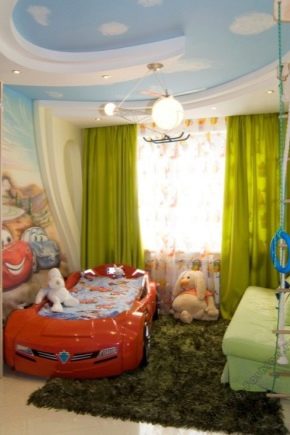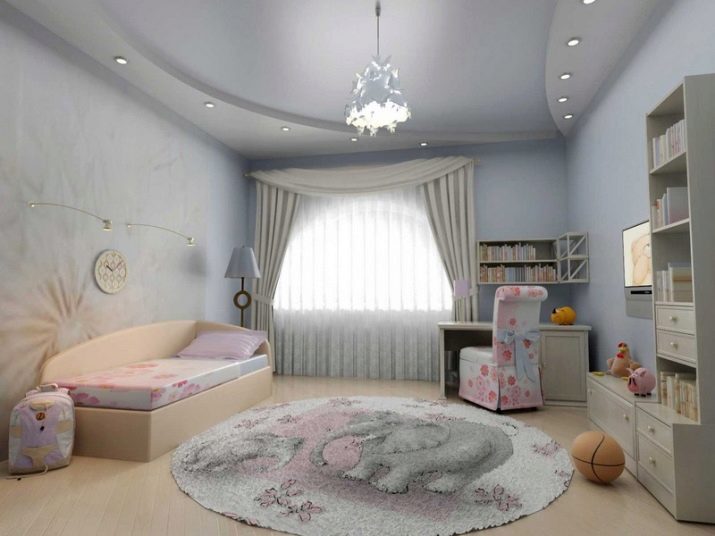Design options for a plasterboard ceiling in a children's room

When choosing the design of a child's room, never rely only on your preferences. It is very important to consult with the child here. Children usually choose something extraordinary. This is why drywall is a great option. This material is able to translate into reality even the most strange and non-standard solutions.

Types of structures
The most common type of ceiling in a children's room is a ceiling of several levels. However, it is not suitable for small rooms. If the height of the walls is not more than 2.5-2.7 meters, then it is better to design a single-level one. With a ceiling height of about three meters, the ceiling can be decorated in two tiers: the first layer of drywall will be continuous and cover the entire ceiling area, and the second is attached only along the perimeter in the form of a frame. A quiet neon light can be installed under this frame.






A less common but more expensive option is a patterned ceiling. It will be difficult to do it yourself, so it is recommended to resort to the help of experienced specialists. Simple figurines such as the sun, figure eight, flower are popular here. There is an option with photo printing. Be very careful: there is a very fine line between an interesting picture and a gaudy picture. You can use a drawing of a cloudy sky or images of characters from popular cartoons.




Combined surface
Another common type of plasterboard ceiling design for boys and girls is a combination of plasterboard and stretch canvas. With the help of these materials, you can bring any idea to life: a ceiling of several levels with a glossy base and matte edges, any geometric shapes, a combination of different contrasts.




Advantages and disadvantages
So let's summarize, and consider all the positive and negative aspects of the GCR.
- The material is absolutely harmless to children due to its environmental friendliness.
- Price policy. The drywall option does not really hit the pocket of the apartment owners.
- Life time. A properly constructed ceiling will serve you over 10-15 years.
- Even a novice master can work with them.
- Ease of construction. Due to its low weight, the gypsum board will not exert any tangible load on the walls. And over time, drywall will not create any problems with dismantling.
- A suspended ceiling made of these slabs will hide all irregularities.

- Electric wires, plastic pipes and the like are easily hidden under sheets of drywall.
- It is possible to install spotlights. This will not only brighten the room, but also provide additional lighting.
- Absolute freedom for imagination. You can create as many levels as you like, layers with any design.
- The ceiling in two or three levels allows you to visually increase the space.
- Fire safety is one of the most important advantages.

However, there are also disadvantages.
- Not very good moisture resistance. Drywall cannot be considered a material that is not afraid of water. If you install it in the bathroom, then you will need a very good range hood. Otherwise, the ceiling will swell, the plaster will begin to come off, and the putty will burst. However, no problems should arise in the children's room.
- Reducing the height of the room. With each new layer of drywall, the ceiling height decreases by 10-15 cm.
- Darkening. After 2-3 years, it may lose its original color.
- The use of drywall is permissible only for old buildings. In houses that were built a couple of years ago, it is undesirable to install a suspended ceiling. In a year or two, the house may settle, and cracks appear in the ceiling.

Varieties of design
Finishing work is carried out using various materials. Plasterboard is usually painted with water-based paint. However, people today are increasingly choosing to use acrylic or vinyl paints and varnishes.

You can add a third-party color to the paint, so you can achieve a custom color. In this case, the brightness of the ceiling will depend on the amount of pigment in the paint.
If you use only water-based paint and varnish product, you will not be able to paint the ceiling in bright colors. The problem is that each new layer of paint will be a different shade. Usually, each subsequent layer is slightly darker than the previous one. If you nevertheless decide to use water-based paint for painting a plasterboard ceiling, then choose light neutral colors.

For bright, cheerful, festive shades, experts recommend using an acrylic or vinyl-based paint and varnish product. There is no need to add color here. They are sold ready-made, you just need to shake the jar and stir. Then you can safely take a roller and paint the ceiling. And also designers use special finishing putties. They are decorative and made for decoration only. Once applied to the ceiling, they are able to form three types of surface: smooth matte, porous and rough.

You can use a putty containing beads or glitter. There are frequent cases when wallpaper is glued to the ceiling. Pay close attention to the seams here. The joints become visible after a couple of months, if the wallpaper is not pasted carefully. As you noticed, there are a lot of options for decorating a plasterboard ceiling. If you combine the light with the false ceiling correctly, you can divide the children's room into different zones. For example, in an area with dim light, you can place a bed, this will be the sleeping part of the room. The play area will be located in the funnier part.

In the modern world, many decorative elements are used to decorate the ceiling. These include self-adhesive. They can be anything from mushrooms and flowers to castles and butterflies. These elements are attached to a pre-prepared ceiling: fresh paint or glue. If the drywall is not painted, but simply putty, then it is not recommended to resort to the use of self-adhesive, as they do not contact well with plaster or putty.

Another interesting design option is the diagonal ceiling. It is similar to a frame-like ceiling. Here, too, the initial layer is a smooth, solid surface. The bottom layer, that is, the diagonal, is a well-lit drywall sheet. This ceiling design would be ideal for a teenager. Indeed, while the child is doing his homework, the room will have excellent lighting.
For information on how to decorate a plasterboard ceiling in a children's room, see the next video.













The comment was sent successfully.